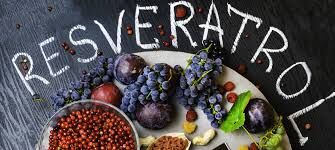As a plant-derived substance, resveratrol can be found in various dietary sources including grapes, berries, peanuts, and red wine. Another important source of resveratrol is the Japanese knotweed, which has long been used in Japan and China as a traditional herbal remedy. Interestingly, the grape and more precisely the grape skin contains the highest concentration of resveratrol. Consequentially, red wine seems to be the most concentrated food source of resveratrol found in human diet. However, it is not possible to absorb the recommended therapeutic doses of resveratrol by drinking wine or through dietary sources.
Resveratrol is a powerful antioxidant with remarkable anti-inflammatory properties. Inflammation and pain play an important role in the pathogenesis of knee osteoarthritis and could cause tissue damage and morbidity. A Randomized Placebo-Controlled Study Published in “Journal of Medicinal Food” Dec 2018 reported:
” The resveratrol-treated group experienced a time-dependent significant decrease in pain severity. These findings suggest that resveratrol may be effective in the treatment of patients with mild to moderate knee osteoarthritis.”
Aging cognitive impairment is associated with an oxidative stress increase. Antioxidant properties of resveratrol are well known as a method of reducing oxidative stress. Improved cognitive capacity, cognitive function, spatial memory, long term memory. cerebral blood flow.
Among age-related neurodegenerative diseases, Alzheimer’s disease, Parkinson’s disease, and multiple sclerosis are the most common. In such disorders, oxidative stress and neuro-inflammation play a significant role.
Traditionally, resveratrol has been used for stomachache, hepatitis, arthritis, urinary tract infections, fungal diseases or skin inflammation treatment, but the main biological potential of resveratrol belongs to cardioprotection.
Resveratrol works its heart-support “magic” in two ways. First off, it protects the endothelium, the delicate inner layer of your arteries, from oxidative free radical damage. Second, resveratrol helps to protect the production of nitric oxide, the critical chemical produced by the endothelium that keeps blood vessels optimally dilated.
There have now been more than 4,400 studies on the benefits of resveratrol to date, showing that it helps to protect your entire body. One study published in the Mar. 2016 issue of “Clin Exp Hypertens” concluded that resveratrol significantly lowered blood pressure.
Apart from its cardioprotective effects, resveratrol also exerts anticarcinogenic, antiviral, neuroprotective, anti-inflammatory, antimicrobial, anti-diabetic, anti-obesity, anti-atherosclerosis and antioxidant properties. The effects of oral resveratrol based nutritional supplement were administrated to octogenarians suffering from age-related macular degeneration. The daily oral intake of the supplement for 12 weeks providing 100 mg of resveratrol significantly restored the retinal structure and visual function.
Numerous studies have demonstrated that resveratrol possesses antitumor action and is a likely candidate for treatment and prevention several types of cancer.
Besides, the phytoestrogen, resveratrol has received great attention as an upcoming preventive and therapeutic agent against breast cancer. Globally, many in vitro and animal-based studies have demonstrated such preventive anticancer activity in colon, cervical, prostate, breasts and lungs. “Biomedicines” Sept 2018.
Preclinical studies have shown that resveratrol exerts immunomodulatory effects with potential clinical value in the reduction of autoimmune disorders. Meta-analysis of 36 randomized controlled trials found a significant reduction in body weight, Body mass index (BMI), fat mass and waist circumference. In addition, resveratrol counteracted some harmful effects of diet-induced obesity and reduced insulin resistance in animal models. Data from clinical trials indicate that daily doses of resveratrol between 20 mg and 2 g are safe and well tolerated.












